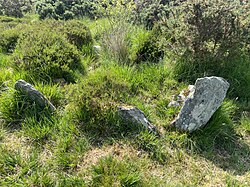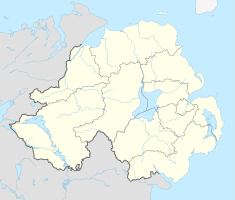Ballygroll Prehistoric Landscape is an 11 acre site in the townland of Ballygroll, County Londonderry, Northern Ireland. It is a Scheduled Monument and a Monument in State Care. The range and extent of the monuments is remarkable ranging in age from the Neolithic Period until the Late Bronze Age.[1] Most of the monuments on the site have not been fully excavated but it includes several cairns, alignments, standing stones, three different types of grave, a barrow, and a field wall system.
| Ballygroll Prehistoric Landscape | |
|---|---|
 An example of a wedge tomb in the landscape. | |
| Type | Collection of prehistoric monuments |
| Location | Ballygroll, County Londonderry, Northern Ireland |
| Coordinates | 54°58′04″N 7°10′05″W / 54.9677°N 7.16814°W |
| Area | 11 acres |
| Built | From the Neolithic to the Late Bronze Age |
| Governing body | Department for Communities |
| Type | Monument in State Care |
| Condition | Varied - Some remains to well preserved |
| Local Authority | Derry City and Strabane |
Background
editThe area around the south and west flanks of Loughermore Mountain was first recorded as being an area with a significant number of ancient monuments in Ordnance Survey memoirs in 1835. However, many of these monuments have been damaged or destroyed. In 1815, a 'Giant’s Grave' was damaged by the landowner when he heard there was treasure buried there. He dug into the grave and removed two flag stones.[2] It is likely that other monuments in the area were destroyed by others in a vain search for treasure over the years.[3] Other monuments were destroyed as the area began to be turned from peat bog, which had preserved the monuments, into arable land. Around 1970 some of the ancient field walls were completely removed in the Highmoor townland, just north of Ballygroll.[4] The whole area was threatened with further damage or destruction by a scheme planned for 1978, however an 11 acre site was saved, when the land was transferred to the Department of the Environment in 1973.
The first proper description of the monuments occurred in 1940,[5] however no full excavations occurred until 1978 when a 6m square segment of the field walls in the Mullaboy townland were excavated. A second excavation occurred in 1979 when archaeologists excavated a covered mound that they discovered was a barrow. The remaining sites have not been fully excavated, and are all at least partly covered in a layer of peat.
List of Ancient Monuments
editThe following list describes the different ancient monuments that are part of the site.
| Type | Excavated? | Condition | Description |
|---|---|---|---|
| Court tomb | No | Some remains | The most northerly of the monuments of the site, it is also likely the oldest. One orthostat remains of a façade leading to a roofless gallery. The grave contains two chambers, only one of which has been left undisturbed.[6] |
| Barrow and pit | Fully | Well preserved | Excavated in 1979 it was discovered to be a barrow 4m in diameter with a further 7m earthen (something). Radiocarbon dating shows the barrow to have been created around 730 BC, which places it in the Late Bronze Age. Below the barrow is a much earlier pit, radiocarbon dated to roughly 1920 BC. As no items were found during the excavation, the purpose of either the barrow or pit cannot be confirmed. However, as no bones were discovered, it is unlikely that it was used for burials.[7][8] |
| Wedge grave | No | Well preserved | At the site there is the presence of a well-defined heel-shaped cairn and is likely an intact wedge grave.[9] |
| Cist grave | No | Some remains | The site is set within a cairn and heavily covered in bog. It is framed by a single slab and it is unroofed and dug out. It is likely a cist grave.[10][11] |
| Stone circle | No | Some remains | The western of two stone circles, set a few metres apart. This one is made of two concentric circles, with the outer circle containing 18 stones and the inner circle containing 17 stones. |
| Stone circle | No | Some remains | The eastern of two stone circles, set a few metres apart. This one is a partial circle comprising 21 stones. There are five stones set outside of this circle which may form part of an alignment running east.[12] |
| Wedge grave | Partially | Substantial remains | A wedge grave which includes three orthostats and a capstone, with outer walling on both sides. When the site was first properly documented, some pottery was found underneath the capstone.[13] |
| Cist graves | No | Well preserved | Two recumbent stones that are a short distance from each other. Both are likely capstones to two cist graves.[14][15] |
| Cairn | No | Well preserved | Heather covered cairn that has been significantly dug out.[16] |
| Wedge grave | No | Some remains | The small, complex, Neolithic structure is likely a wedge grave. It is one of the structures on the site most visible to visitors.[17] |
| Cist grave | No | Some remains | A recumbent stone that is likely the capstone to a cist grave. It is considered part of the scheduled monument but is slightly south of the land owned by the government.[18] |
| Standing stones | No | Well preserved | Two small quartz stones that may form part of a larger set of stones that remain uncovered. Only identified in 2008 due to heather burn.[19] |
| Standing stones | No | Well preserved | Two small schist stones. Only identified in 2008 due to heather burn.[20] |
| Stone alignment | No | Well preserved | Alignment of at least six stones over a distance of 8.5m and first identified in 2008.[21] |
| Stone alignment | No | Well preserved | Alignment of at least three stones, set between 0.3m and 2m apart. First identified in 2008 due to heather burn.[22] |
| Field walls | Partially | Some remains | Seven field walls have been identified within the landscape, however some of them fall outside of the area owned by the government. In 1978 a 6m square segment was excavated. Radiocarbon dating from peat samples taken from underneath a collapsed section of the wall roughly corresponded with 80 BC.[23][24] |
References
edit- ^ "Ballygroll Prehistoric Landscape". Department for Communities. Retrieved 26 Jun 2023.
- ^ Williams, B.B; Pearson, G.W.; Edwards, Kevin J. (1981–1982). "Ordnance Survey Memoir, Parish of Lower Cum- ber, County Londonderry, 1835 (Appendix 2)". Ulster Journal of Archaeology. 44/45: 41–43. JSTOR 20567864. Retrieved 26 Jun 2023.
- ^ Davies, O. (1948). "The Ancient Fields at Ballygroll, Co. Derry". Ulster Journal of Archaeology. 11: 53. JSTOR 20566549. Retrieved 26 Jun 2023.
- ^ Williams, B.B; Pearson, G.W.; Edwards, Kevin J. (1981–1982). "A Prehistoric Complex at Ballygroll and Mullaboy, County Londonderry". Ulster Journal of Archaeology. 44/45: 31. JSTOR 20567864. Retrieved 26 Jun 2023.
- ^ Williams, B.B; Pearson, G.W.; Edwards, Kevin J. (1981–1982). "A Prehistoric Complex at Ballygroll and Mullaboy, County Londonderry". Ulster Journal of Archaeology. 44/45: 29–46. JSTOR 20567864. Retrieved 26 Jun 2023.
- ^ "Cromlech". Department for Communities. Northern Ireland Sites & Monuments Record. p. LDY-023:006. Retrieved 26 Jun 2023.
- ^ "Barrow". Department for Communities. Northern Ireland Sites & Monuments Record. p. LDY-023:040. Retrieved 26 Jun 2023.
- ^ Williams, B.B; Pearson, G.W.; Edwards, Kevin J. (1981–1982). "A Prehistoric Complex at Ballygroll and Mullaboy, County Londonderry". Ulster Journal of Archaeology. 44/45: 33–35. JSTOR 20567864. Retrieved 26 Jun 2023.
- ^ "Wedge Grave or Cairn?". Department for Communities. Northern Ireland Sites & Monuments Record. p. LDY-023:039. Retrieved 26 Jun 2023.
- ^ "Cairn". Department for Communities. Northern Ireland Sites & Monuments Record. p. LDY-023:013. Retrieved 26 Jun 2023.
- ^ Williams, B.B; Pearson, G.W.; Edwards, Kevin J. (1981–1982). "A Prehistoric Complex at Ballygroll and Mullaboy, County Londonderry". Ulster Journal of Archaeology. 44/45: 29–46. JSTOR 20567864. Retrieved 26 Jun 2023.
- ^ "Two stone circles & possible alignment". Department for Communities. Northern Ireland Sites & Monuments Record. p. LDY-023:021. Retrieved 26 Jun 2023.
- ^ "Wedge Tomb". Department for Communities. Northern Ireland Sites & Monuments Record. p. LDY-023:037. Retrieved 26 Jun 2023.
- ^ "Recumbent Stone & Cist Grave". Department for Communities. Northern Ireland Sites & Monuments Record. p. LDY-023:036. Retrieved 26 Jun 2023.
- ^ "Recumbent Stone & Cist Grave". Department for Communities. Northern Ireland Sites & Monuments Record. p. LDY-023:034. Retrieved 26 Jun 2023.
- ^ "Round Cairn". Department for Communities. Northern Ireland Sites & Monuments Record. p. LDY-023:035. Retrieved 26 Jun 2023.
- ^ "Cromlechs". Department for Communities. Northern Ireland Sites & Monuments Record. p. LDY-023:017. Retrieved 26 Jun 2023.
- ^ "Recumbent Stone & Cist?". Department for Communities. Northern Ireland Sites & Monuments Record. p. LDY-023:032. Retrieved 26 Jun 2023.
- ^ "Standing Stones". Department for Communities. Northern Ireland Sites & Monuments Record. p. LDY-023:069. Retrieved 26 Jun 2023.
- ^ "Standing Stones". Department for Communities. Northern Ireland Sites & Monuments Record. p. LDY-023:070. Retrieved 26 Jun 2023.
- ^ "Stone Alignment". Department for Communities. Northern Ireland Sites & Monuments Record. p. LDY-023:071. Retrieved 26 Jun 2023.
- ^ "Stone alignment". Department for Communities. Northern Ireland Sites & Monuments Record. p. LDY-023:072. Retrieved 26 Jun 2023.
- ^ "Field System". Department for Communities. Northern Ireland Sites & Monuments Record. p. LDY-023:041. Retrieved 26 Jun 2023.
- ^ Williams, B.B; Pearson, G.W.; Edwards, Kevin J. (1981–1982). "A Prehistoric Complex at Ballygroll and Mullaboy, County Londonderry". Ulster Journal of Archaeology. 44/45: 31–33. JSTOR 20567864. Retrieved 26 Jun 2023.
